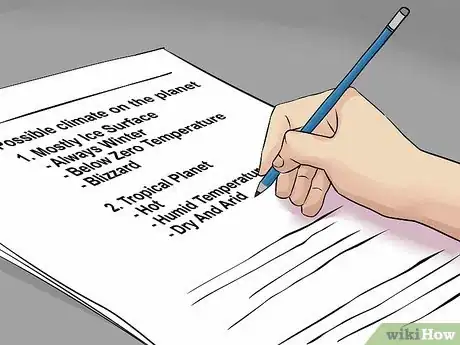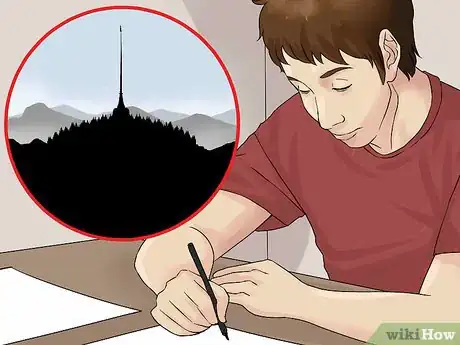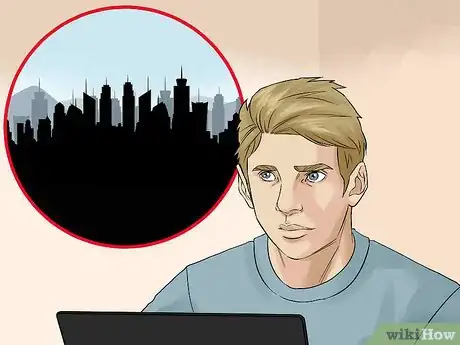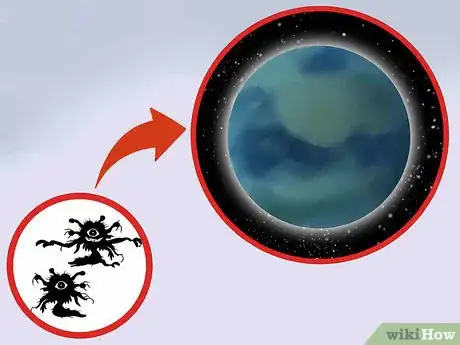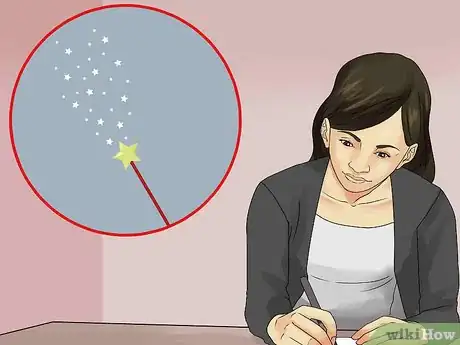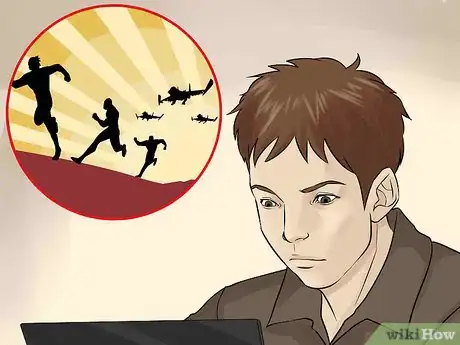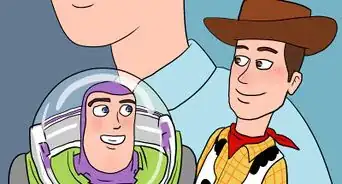This article was co-authored by Grant Faulkner, MA. Grant Faulkner is the Executive Director of National Novel Writing Month (NaNoWriMo) and the co-founder of 100 Word Story, a literary magazine. Grant has published two books on writing and has been published in The New York Times and Writer’s Digest. He co-hosts Write-minded, a weekly podcast on writing and publishing, and has a M.A. in Creative Writing from San Francisco State University.
There are 9 references cited in this article, which can be found at the bottom of the page.
wikiHow marks an article as reader-approved once it receives enough positive feedback. In this case, several readers have written to tell us that this article was helpful to them, earning it our reader-approved status.
This article has been viewed 126,873 times.
Maybe you are writing a science fiction novel and are in need of a fictional planet to serve as the setting for your story. Or perhaps you plan to design the fictional planet first and then worry about how your characters inhabit the planet later. You should consider the physical aspects of the planet as well as the species that live on the planet. You should also decide on the rules of the planet and how the fictional planet is going to function in your story.
Steps
Determining the Physical Aspects of the Planet
-
1Describe the atmosphere of the planet. Start by considering if the planet is made up of gases like oxygen and nitrogen, or with other gases not found on Earth. Humans need oxygen to survive, but if your planet is not going to be populated with humans, your planet may not need oxygen at all. Your planet may be made up of one gas that requires special equipment to breathe in, or several gases that mirror the atmospheric make up of Earth.[1]
- You may want to consider if you are trying to create a believable or realistic planet where humans can survive or if you are going for the fictional effect and not worrying about plausibility at all. You may end up creating an atmosphere for the planet that is similar to Earth so your reader is more likely to believe human life can survive on the planet.
- You should also think about how the atmosphere appears on the planet. Is the atmosphere foggy and thick with white gases or does it have patches of poisonous gases that appear green or blue? Maybe sections of your planet contain different atmospheres, leading to a wide range of gases and elements on the planet.
-
2Note the climate of the planet. You should also have a good idea of the climate or climates on the fictional planet. Consider if the planet has a variety of climates based on location or one overall climate.[2]
- Maybe the planet consists mostly of ice and it is always winter on the planet, with temperatures below zero. Or, perhaps there are areas of the planets that are tropical, with hot, humid temperatures and areas of the planet that are dry and arid.
Advertisement -
3Decide if there will be seasons on the planet. You should consider if there are going to be seasons on the planet and if so, how many seasons will there be. The seasons on the planet may mirror the seasons on planet Earth, consisting of spring, summer, fall, and winter. Maybe the seasons are limited to two, summer and winter, or there is only one constant season on the planet.[3]
- You may want the seasons to correspond with the climate and the atmosphere of the planet. Perhaps a planet that is made mostly of frozen water will have only one season: winter. Or, if the climate is tropical on the planet, it may be summer year round.
- Keep in mind the names of seasons on the planet can also be different than the ones we have on Earth. You are creating a fictional planet, after all, so you have the freedom to come up with new names for seasons and include them in your story.
-
4Describe the landscapes on the planet. Think about how the planet looks in terms of landscape and terrain. Try to be specific about the landscapes on the planet and connect the landscape with the climate and atmosphere of the planet. This will make the planet seem more believable and cohesive to your reader.[4]
- Perhaps the planet consists of a variety of landscapes, such as ice capped mountains, grassy hills, desert plains, and tropical jungle. Or, maybe there is only one type of landscape on the planet, such as a planet made of ice that contains glaciers, ice walls, and frozen forests.[5]
- You should also consider if there are going to be bodies of water on the planet, such as oceans, lakes, and rivers. Perhaps there is only one long body of water that circles the entire planet or several lakes that are considered sacred to the people living on the planet.
-
5Note if there are distinct landmarks on the planet. Most planets that have been settled by a species will have distinct landmarks that have been built or created, such as a giant central tower or a monument to a particular historical figure. There may also be natural landmarks on the planet, like a sacred mountain peak or a dense, preserved forest.[6]
- You can make a specific landmark a key element in the journey of your protagonist so the landscape feels central to your story. Maybe your protagonist has to journey to a central tower to receive important information from the planet’s government. Or, maybe your protagonist is searching for a key buried in a sacred mountain on the planet.
-
6Describe any natural resources on the planet. You should consider if there are going to be natural resources, like minerals or natural gas, on the planet. These natural resources could then serve an important purpose in your story set on the planet, as your characters may try to extract or use these natural resources for their own gain.
- You may include mineral resources like gold, iron, or coal. There may also be precious stones like diamonds or pearls on the planet.
- You may include natural resources like fossil fuels or natural gas. Or, the planet may contain lots of forests for timber and fertile land for growing crops.
-
7Decide if there will be cities, towns or villages on the planet. You should decide if your planet will be divided into settled areas like cities, towns, or villages. Perhaps there are only a handful of major cities on your planet, and lots of small villages in remote areas. Or, maybe your planet is full of urban areas and large cities, with only a small amount of rural villages or areas.
- You should consider how the planet's cities, towns, and villages are going to factor into your story. Maybe your protagonist lives in a large city in a specific spot on the planet. Perhaps your antagonist lives in a remote town. Consider how you are going to use the lay out of the planet in your story and build it from there.
-
8Create a map of the planet. To get a better sense of the overall geography of the planet, you should sit down and sketch out a map. It does not necessarily have to be well rendered or well drawn. Instead, focus on getting down the general details of the planet, such as the names of the areas on the planet as well as key features of each area.[7]
- For example, maybe you are creating a planet that is divided into two sides: one of ice and one of sand. You may then label one side “Frigid Land” and list details about the atmosphere, climate, and landscape in this area. You may list: “Blue atmosphere, below zero temperatures, populated by glaciers, ice walls, snow-capped mountains, and sparse forest.”
Designing the Species on the Planet
-
1Note the different life forms on the planet. You should consider who is inhabiting the fictional planet. Maybe you have human-like species who live on the planet or alien-like species who have colonized the planet. Perhaps there is a mix of both species who attempt to live in harmony on the planet.[8]
- Determine a rough estimate of the population of the different species on the planet. Maybe humans are outnumbered by aliens, or humans and aliens are outnumbered by a species of animal on the planet.
- You should consider the different races that live on the planet. Maybe there are different races of humans who live in specific areas or locations on the planet. There may be different races of aliens as well who only inhabit a specific area on the planet.
-
2Create unique biodiversity for the planet. Consider the flora and fauna that exist on the planet, from mammals to insects to plant species. Try to be detailed about the biodiversity, as it can tell your reader a lot about the physical aspects of the world. It can also serve as useful plot points or character moments, where your character interacts with the biodiversity on the planet.[9]
- You may want to try using some of the unique biodiversity found on Earth as a jumping off point. Do some research on strange biodiversity on Earth and put it in as part of your planet’s biodiversity.[10]
- Another option is to take an existing plant or animal and make them more unique or strange. Your planet may be populated by grapevines that excrete blood, for example, or wildebeests who are only two inches tall. Get creative and turn familiar elements of our world into unique ones for your fictional planet.
-
3Describe the history of the species on the planet. You should also consider how the species ended up on the planet and the events that lead to the creation of the planet. Sketch out a history of the planet, before and after it was settled by a species. You can then include plot points and characters from your story in the history of the planet.[11] [12]
- You should consider the origin of the planet and the species. Is the planet a distant star that was inhabited by aliens who crash landed on it? Or did the species grow and evolve on the planet over a long period of time?
- You should also consider major events in the history of the planet. Maybe the aliens who crash landed had to overthrow a species who already lived on the planet. Or perhaps the species who evolved on the planet had to survive the dark ages to then be prosperous on the planet.
-
4Decide if the species will use technology on the planet. You should also consider how technologically savvy your species is going to be on the planet. Does your species have access to advanced technology that uses signalling stations on the planet? Or does your species use technology that is very similar to Earth's capabilities, with access to wi-fi and high speed internet?
- Keep in mind you are creating a fictional planet and you do not need to stick to realistic ideas of technology. You have the freedom to create your own versions of existing technology, such as cellphones that are called beam-hands or a version of the internet that is called simply "the Net". Get creative and do not be afraid to create your own technologies for the species on your planet.
Creating the Rules of the Planet
-
1Decide how magic works on the planet. You may decide to include magical elements on your planet, especially if you are writing a sci-fi fantasy story. Determining how magic functions on the planet will allow you to then use the magical elements of the planet in your story.
- For example, perhaps there is a specific area of the planet that is known for its magical forest, which seems to swallow up anyone who enters. Or maybe the planet contains patches of green gas that can suffocate anyone who is not wearing the proper breathing gear.
- There may also be magical beings who exist as species on the planet. You may limit magic to only these magical beings, who bring magic with them, rather than have magic be a part of the planet’s make up.
EXPERT TIPGrant Faulkner is the Executive Director of National Novel Writing Month (NaNoWriMo) and the co-founder of 100 Word Story, a literary magazine. Grant has published two books on writing and has been published in The New York Times and Writer’s Digest. He co-hosts Write-minded, a weekly podcast on writing and publishing, and has a M.A. in Creative Writing from San Francisco State University.Professional Writer
 Grant Faulkner, MA
Grant Faulkner, MA
Professional WriterTreat your new world as a real world with its own physical rules. Whether you're creating a world on another planet or one on Earth, you need to know the rules. If there is magic, understand how it works in relation to the physical rules. If people can fly, there are still rules on how fast or high they can fly. Creating a realistic new world is about the way you define the rules and then being consistent.
-
2Determine if the planet will be hospitable. You should also consider if the planet is friendly, dangerous, or a bit of both. Maybe the planet is only hospitable to certain species, such as aliens or magical beings, and it is threatening to humans. Or maybe the planet has areas that are known to be dangerous and unsafe for anyone who enters.[13]
- You may decide to treat the planet as another character in your story, with a mind of its own. Perhaps it creates conflict for your characters, where they have to escape the inhospitable planet to stay alive.
-
3Note how the planet functions within a larger system. You should also try to get a macro sense of the planet, where you consider if and how the planet exists within a larger system of planets. Maybe the planet is light years away from the nearest planet or perhaps it is under the domain of a larger planet in the solar system.[14]
- You should consider where the planet is located exactly within a larger system.
- The rules of the planet may also be based on its position in a solar system, where it is limited by a larger planet or in control of smaller planets. Think about the positioning of the planet in relation to other planets and celestial bodies, such as stars, meteorites, and black holes.
Community Q&A
-
QuestionA continent on my planet is heavily inspired by the Native Americans. How can I create individuality?
 Community AnswerAdd features that would not be typically Native American, or combine American civilization with another civilization and base it off of that.
Community AnswerAdd features that would not be typically Native American, or combine American civilization with another civilization and base it off of that. -
QuestionI'm trying to create a planet for science class. What should I do?
 Community AnswerCombine different characteristics of the existing planets and use your imagination!
Community AnswerCombine different characteristics of the existing planets and use your imagination! -
QuestionI'm trying to create a planet that manufactures other planets. How should I do it?
 Community AnswerMaybe it could be a gas giant and the inhabitants could be super technologically advanced.
Community AnswerMaybe it could be a gas giant and the inhabitants could be super technologically advanced.
References
- ↑ https://climate.nasa.gov/news/2915/the-atmosphere-getting-a-handle-on-carbon-dioxide/
- ↑ http://www.geocurrents.info/geographical-thought/geography-and-science-fiction-the-creation-of-realistic-alternative-worlds
- ↑ https://science.nasa.gov/science-news/science-at-nasa/2000/interplanetaryseasons
- ↑ https://penandthepad.com/writing-tips-write-scenery-novels-8696432.html
- ↑ http://io9.gizmodo.com/the-worst-blunders-people-make-in-inventing-fictional-a-1527153617
- ↑ http://h2g2.com/approved_entry/A1151731
- ↑ http://thewritelife.com/worldbuilding/
- ↑ http://h2g2.com/approved_entry/A1151731
- ↑ http://thewritelife.com/worldbuilding/
About This Article
If you want to create a believable fictional planet, start by making its climate. For example, do you want your planet to be mostly hot or cold, or balanced like Earth’s? Since a big part of your planet’s climate are its seasons, decide whether you want simply a winter and summer, or if you want to go big and give it 10 seasons! Then, choose the technology you’ll have on your planet, and if magic should exist too. Once you’re happy with how your planet works, plan your cities and towns, and draw a fictional map to get a feel for how it all looks. For more tips, including how to create the planet’s life forms and plants, scroll down!

